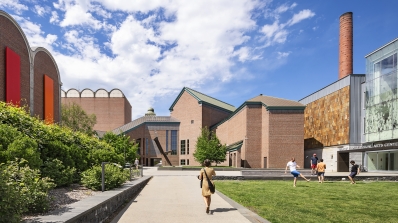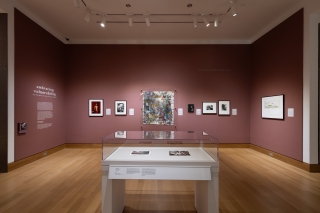Exhibitions Archive
Illuminating the Beauty of Islamic Art
Faces of FaithFaces of Faith presents a focused look at a group of artists who engage in diverse forms of the Islamic visual tradition from the 11th century to the present. It begins with Quranic scriptures, calligraphy, and geometric patterning, modes that have long occupied a defining position in historical Islamic art. This is juxtaposed with photography and contemporary art prints that focus on the individual experience. This exhibition demonstrates that Islam is not a monolithic culture but a dynamic and rich faith.
What is Islamic art? What is the role of individual identity in the face of the universal principles of Islam? Faces of Faith argues for a complex response to these questions. Themes like gender and diaspora have long shaped feelings of identity and belonging. By engaging in these themes within the Islamic visual tradition, these artists both capture and contribute to the beauty and diversity of Muslim identity. Viewers are invited to explore the interconnected and enduring themes of resilience, empowerment, identity, and spirituality that infuse Islamic art.
A Space for Dialogue is a student-curated exhibition program that began in 2001. Hood Museum of Art interns create an installation drawn from the museum's permanent collection by engaging with every aspect of curation, from doing research and selecting objects, to choosing frames and a wall color, to planning a layout and writing labels and a brochure, to giving a public talk. There have been over 100 A Space for Dialogue exhibitions on a wide variety of themes.
Gay Intimacy in the Context of AIDS
Embracing VulnerabilityEmbracing Vulnerability: Gay Intimacy in the Context of AIDS reclaims gay sexuality as something intimate, affirming its beauty in the face of the legacy of state-sanctioned discrimination and marginalization during the height of the AIDS epidemic. The way in which these works reckon with this history through tender depictions of intimacy reframes queer male sexuality as natural and desirable rather than dangerous and obscene.
A Space for Dialogue is a student-curated exhibition program that began in 2001. Hood Museum of Art interns create an installation drawn from the museum's permanent collection by engaging with every aspect of curation, from doing research and selecting objects, to choosing frames and a wall color, to planning a layout and writing labels and a brochure, to giving a public talk. There have been over 100 A Space for Dialogue exhibitions on a wide variety of themes.
A Brew of Cultural Symbolism, Solace, and Introspection
Coffee and Tea in ArtFor centuries, coffee and tea have served as primary staples in daily life to stimulate productivity and foster community. This exhibition explores how their cultural symbolism is reflected in art. At times, artists feature coffee and tea to represent stability and reflect broad, popular sentiment. Their routine enjoyment across cultures also offers a unique artistic window onto the self and our everyday experiences.
A Space for Dialogue is a student-curated exhibition program that began in 2001. Hood Museum of Art interns create an installation drawn from the museum's permanent collection by engaging with every aspect of curation, from doing research and selecting objects, to choosing frames and a wall color, to planning a layout and writing labels and a brochure, to giving a public talk. There have been over 100 A Space for Dialogue exhibitions on a wide variety of themes.
Gender, Belonging, and Nationhood
Sports CultureThis exhibition explores the ways in which identity is invented and intertwined through athletics. The works move beyond their individual subjects to examine the impact of sports upon the formulation and imposition of collective identities across space, time, and people. Spanning from the 19th through the 21st centuries, this exhibit explores topics such as cultural pride, the assertion of state power, collective nationality, and gender expectations.
A Space for Dialogue is a student-curated exhibition program that began in 2001. Hood Museum of Art interns create an installation drawn from the museum's permanent collection by engaging with every aspect of curation, from doing research and selecting objects, to choosing frames and a wall color, to planning a layout and writing labels and a brochure, to giving a public talk. There have been over 100 A Space for Dialogue exhibitions on a wide variety of themes.
reflections on our collective psyche
Apocalypse WhenThe motif of apocalypse in art explores the timeless fascination with an imminent, final destruction. From 20th-century prints to innovative digital installations, this exhibition captures various apocalyptic interpretations of catastrophic historical events and modern anxieties, while also evoking a sense of shared humanity, humor, and hope in the face of disaster.
A Space for Dialogue is a student-curated exhibition program that began in 2001. Hood Museum of Art interns create an installation drawn from the museum's permanent collection by engaging with every aspect of curation, from doing research and selecting objects, to choosing frames and a wall color, to planning a layout and writing labels and a brochure, to giving a public talk. There have been over 100 A Space for Dialogue exhibitions on a wide variety of themes.
Connecting Threads and Woven Stories gives a glimpse into the rich and diverse textile traditions of Southeast Asia. The textiles vary in style, material, and technique, including nineteenth-century Indonesian tapis, a Vietnamese photo-weaving, and a contemporary Thai textile woven with jewel beetle wings. Despite their differences, these textiles tell the stories of the peoples who made them, their cultural values, and their legacies.
A Space for Dialogue is a student-curated exhibition program that began in 2001. Hood Museum of Art interns create an installation drawn from the museum's permanent collection by engaging with every aspect of curation, from doing research and selecting objects, to choosing frames and a wall color, to planning a layout and writing labels and a brochure, to giving a public talk. There have been over 100 A Space for Dialogue exhibitions on a wide variety of themes.





